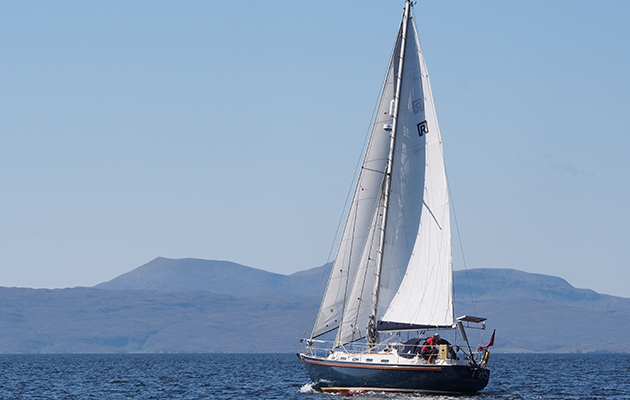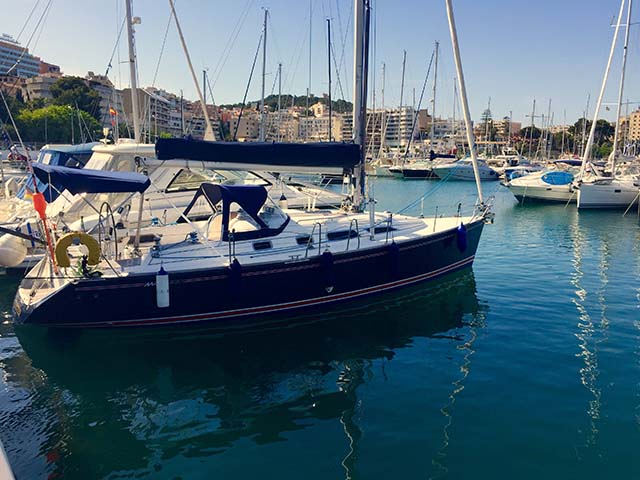Facing shipwreck on a lee shore didn’t put him off sailing, but then having only one limb of four working didn’t put this MS sufferer off climbing. Dick Durham meets Dr Roger Chisholm
The Irish Sea is in a fury: however many assaults it makes on the shoreline, Anglesey refuses to budge.
Wave after wave of white horses charge into Trearddur Bay, exploding on black rocks and vapourising into a fog of spindrift which peppers the windows of the clifftop home before being wiped clean by driving rain until the next stampede.
Behind the weeping panes sits Dr Roger Chisholm, smartly dressed in a blue and white checked shirt, well-pressed denims and polished leather deck shoes, his open, intelligent face beaming with a reflective smile as he recounts yarns of derring-do.
This could be any retired sailor looking back on a lifetime of adventure but in Roger’s case, his repose is catered for not by an armchair, but a wheelchair, and his room is on the top floor of an end-of-life care home.

One of the highlights of Roger’s sailing career – rounding Ardnamurchan
‘Help yourself,’ he says, lifting a punnet of red grapes towards me as we sit listening to the winter storm whistling ominously through the UPVC window frames.
‘That noise reminds me of the one gale which caught me out in 50 years of sailing,’ he says, closing the bedroom door to shut out the cacophony of bustling nurses and their charges.
Roger Chisholm is 66. At the age of 27 he was diagnosed with multiple sclerosis, the disease which affects the nervous system and spinal cord. Yet he spent 40 years battling the symptoms.
He swam 80 lengths of his local pool twice a week; while he could still drive, he refused to fit the blue disabled badge he was entitled to; he cycled the 30 minutes to and from work every day and he refused a walking stick until he could no longer stand without one.

Roger throughly enjoyed cruising The Lofotens
Throughout his active life as a climber and a sailor, he kept looking up.
As the former, he scaled the Austrian alps, trekked around Annapurna in the Himalayas and hiked through Waziristan in Central Asia.
As the latter, he cruised to St Kilda, the Lofoten Islands and Norway.
Having contained the disease, and, looking forward to cruising his beloved Hebrides in his retirement, Roger, a former consultant radiologist from Salford Royal Hospital, was next diagnosed with a malignant brain tumour.

Roger ski-mountaineering in the Silvretta Alps
Following chemotherapy and surgery, he was told his time was limited: maybe a year, maybe a month.
So, with sailing, climbing and hiking forever off limits, Roger instead set about writing his autobiography, Don’t Look Down, An Adventurous Life with MS (Scotland Street Press, £19.99), and made a film, Revising the Dubhs Ridge.
And that is how we came to be talking about his first gale.
‘It wasn’t just blowing, it was screaming. Screaming at you like you’ve got no right at all to be where you are, out on a boat at night, on a lee shore 200 miles from home, on an estuary even more dangerous than the open sea. And the sea itself was raging too, with waves even higher than the mast.’

Even at a young age, Roger was a natural sailor, performing lookout duty on the Firth of Clyde
Roger and three others were aboard a Van de Stadt-designed Harmony 31, on a delivery trip from Kiel to Harwich.
Two of the crew were in their bunks suffering seasickness; leaving Roger and his pal to take three-hour watches under storm jib and trysail, to weather Texel lighthouse against a north-westerly gale.
‘The Elbe estuary is a dangerous place at the best of times, with a tide that runs at 4 knots on the ebb across Scharhorn Riff, sandbanks on one side and one of the world’s busiest sea lanes on the other. We knew that survival depended on being able to steer a course towards the weather side of the lighthouse. Anything else and we would soon be wrecked on sandy, low-lying land.’
Roger’s fortitude that night came from the spartan upbringing he’d had from his hardy parents, Alec and Aline, who took Roger and sister Diana on camping holidays in the Scottish Highlands based around an Enterprise sailing dinghy and a canoe.

Never a dull moment sailing with friend Peter Davies. Credit: Howard Steen
This sparked a love of sailing literature that evolved from Arthur Ransome to Eric Hiscock.
‘He left a mark on me because in the mid-1950s, it was a revolutionary idea, the thought that an ordinary couple could contentedly sail round the world in their own boat.’
As a teenager, Roger sailed with his father in chartered yachts around Skye, the Outer Hebrides and Ireland.
‘It taught me that sailing brings an intensity to life and is never boring. You can go for a weekend’s sailing and return feeling as though you’ve been away for a whole week.’
Continues below…
Downsizing: an age-old conundrum
Bigger isn’t always better. As ageing joints make some jobs harder, Julian Mounter rediscovers the fun and freedom of a…
Heading for home from the high Arctic in a leaking boat
In a bitter north-east wind accompanied by flurries of snow we watched the desolate coast recede. By now, even…
Like the time he sailed with Cambridge friend Bob Bradfield, the creator of Antares Charts profiled in Yachting Monthly, in the latter’s 31ft wooden sloop, Inigo.
They went from Falmouth to Baltimore, Schull, and visited Skellig Michael, one of the stacks that rises 600ft from the sea off the Kerry coast.
‘We took it in turns to climb to the summit, where the monks lived on what clearly must have felt like the very edge of the world. I’ve never yet met anyone who has managed to land on those islands from a yacht, and these days, it’s prohibited.’
Two months later, Roger collapsed at St John’s College and was subsequently diagnosed with MS. ‘It meant I couldn’t climb any more mountains, but it certainly wasn’t going to stop me sailing.’

Catching the wind. Credit: Howard Steen
Indeed, Roger went on to complete his RYA Offshore Yachtmaster and shortly after, made the first of three passages to St Kilda in a Dehler 36.
‘A Harris fisherman had warned me, “Never go there, it’s much too far out” and unless you have a weather window for a 40-mile dash out into the Atlantic and back, it’s sound enough advice. But the lure of the place is so strong.’
On that trip, Roger and crew landed at Village Bay and were met by an Army officer who offered them a beer at the remotest pub in Europe, the Puff Inn.
Roger next sailed his own boat, Minella, a Trintella 29, from her mooring at Port Dinorwic on the Menai Strait to St Kilda, again marvelling at Stac an Armin — at 643ft, the highest monolith in Britain.
Roger’s next boat was a Rival 34, Eugie, but he was disappointed with her and after three seasons, upgraded to a Rival 36, Liberty, which he shared with two friends, Peter Davies and Steve Henderson.

Roger enjoyed 10 years of island sailing on Liberty
‘We performed as a team on the boat as we once did on the hills,’ Roger said about his offshore exploits, although sailing has also included day trips with ex-wife Sally and children, Elinor and Owen.
One reason for rarely heading south to ‘lands where the butter melts’ is that Roger found his MS reduced him to barely more than a cripple: ‘It’s much worse when you’re hot,’ he said, ‘during a charter to Turkey I couldn’t move.’
After such a gruelling experience, he took a charter to Greenland.
Sailing high
But the highlight of his sailing life was a cruise to the Lofoten Islands, a trip Roger had been hankering to make for over 50 years.
The opportunity finally arrived when another Cambridge friend, Howard Steen, bought Martha Maria, a Vancouver 27, and moored her in the Baltic, sailing a little nearer each season to the Lofoten Islands.
In 2011, Roger and Howard sailed her from just north of Bergen over the 800 miles to the ‘frayed chain of granite islands.

Keeping as fit as possible helped Roger to explore even the remote parts of Tromso
‘As it was high summer when we reached them, there was no darkness. At 2330 one night, we inflated the dinghy and rowed away from Martha Maria to take photos of her in the midnight sun. There wasn’t a whisper of wind and the boat was bathed in soft, golden light with mountains and islands all round. If ever I think of the world as a cruel, ugly place, that memory resurfaces to remind me otherwise.’
Aboard Liberty, Roger has explored the Shetland and Orkney Islands and sailed round Cape Wrath; his favourite anchorage is also up in those western isles.

Midnight in the Arctic
‘Of all the anchorages in the Summer Isles, the one we like best is the sheltered channel between the two uninhabited islets of Tanera Beg and Eilean Fada Mor. To the east, the porcupine ridges of Stac Pollaidh stand guard over the surrounding land like a colossal fortress. To the west, the setting sun over the Outer Hebrides turns the Torridon sandstone cliffs even pinker. All this and coral sands, occasional otters, wild flowers and the remote villages of Wester Ross…’
A sudden gust turns the window frame into a high-pitched musical reed and bullets of rain, or spindrift rattle the pane.
Does Roger have words of advice for others facing his dilemma, I wonder?
‘Number one, keep as fit as possible, two, have a passion, three, have goals and four, value your friendships.’

Leaving Scavaig
As is appropriate for a man who has loved the wild places both on and offshore, Roger has left instructions for his ashes to be scattered over both: at his family cottage in Snowdonia and over the waters of his childhood sailing youth at Skye’s Loch Scavaig.
Night has fallen over the Irish Sea.
We can no longer see the breakers but we can still hear them, along with the westerly gale whistling through the window.
Dr Roger Chisholm 21 October 1951 – 17 March 2018






